What are vacuum and pressure equipments?
Vacuum and pressure equipments are essential for laboratory experiments. This is because in order to perform a number of tasks, vacuum systems are required and commonly used in chemistry labs for various purposes.
Vacuum equipment includes devices such as vacuum pumps, vacuum ovens, and vacuum desiccators. These devices are used to remove air and other gases from a reaction vessel or a sample, creating a low-pressure environment. Vacuum equipment is used in a variety of applications, such as distillation, evaporation, filtration, and drying.
Pressure equipment includes devices such as pressure reactors, pressure vessels, and autoclaves. These devices are used to create a high-pressure environment for reactions that require pressure to proceed. Pressure equipment is used in a variety of applications, such as polymerization, hydrogenation, and synthesis of specialty chemicals.
Depending on the pressure required, there are different types of equipments.
Water trompe (water aspirator pump)
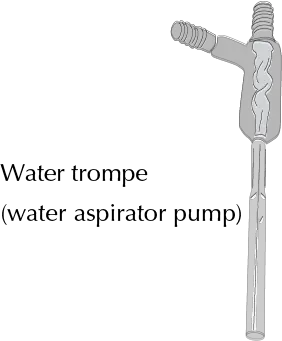
One of the most popular vacuum devices, it is used when pressures around 20 mmHg are required. The generated vacuum depends on the temperature and the flow rate at which the water circulates. The water tubes are made of glass or plastic, have a side opening to which the equipment to where the vacuum is to be applied is connected by means of a vacuum hose, and is firmly attached to the tap, either with a threaded system or with another vacuum hose and a clamp.
The tap water enters through the top of a straight pipe that passes through a narrowing and is eliminated through the drain. This increases the velocity of the water, which causes the surrounding air to be sucked out by the Venturi effect, generating a continuous vacuum.
This type of device has two disadvantages, on the one hand the high water consumption, and that if there is a change of pressure of the running water, water can flow back from the tube to the system in which the vacuum is being made. This last disadvantage can be avoided by placing a trap to collect the possible excess water.
Traps can be used not only in water tubes but in most vacuum and pressure equipment as a safety device.
Recirulating water wacuum pump
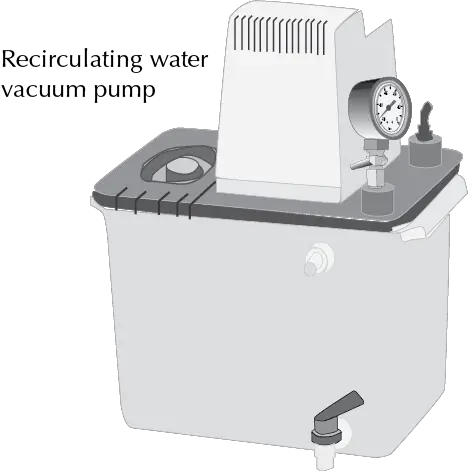
To avoid the excessive water consumption of the water tubes, water pumps were designed, which perform vacuum with the same principle (Venturi effect) but instead of using tap water, they use a closed circuit formed by a water tank and an electric motor that provides the flow. They have the advantage of providing a pressure without fluctuations, and the disadvantage that the water temperature increases with long periods of use, thus decreasing the vacuum.
Diaphragm vacuum pump
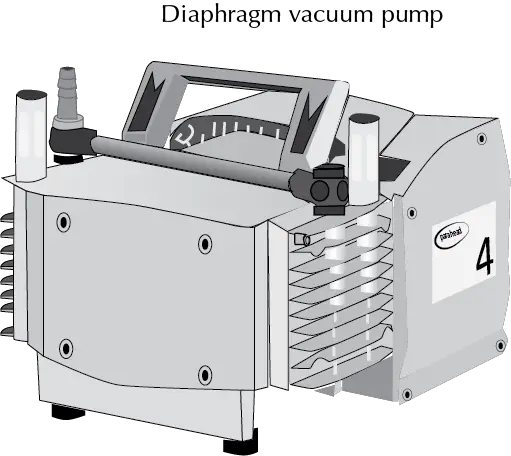
When we need lower pressures in the vacuum system, we resort to diaphragm pumps. These are electrical devices that generate vacuum by pushing elastic walls (membranes) that vary the volume of a chamber alternately. In addition, they are specially designed to resist attack by volatile organic solvents.
Peristaltic pump
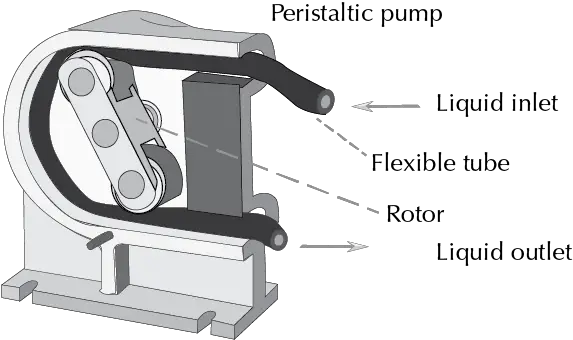
It allows to pump a fluid contained in a flexible tube by means of a rotor that with a series of moving rollers drags the fluid from the flexible tube by compression of the same. The fluid never comes into contact with the pump elements, so the fluid (clean or sterile liquid) is not contaminated, nor does it damage the pump elements in case it is corrosive. Also, it will be suitable to generate an air flow at low or moderate pressures.
High vacuum pump
They are electrical devices similar to diaphragm pumps, but can generate vacuums of less than 0.1 mmHg, by means of a mechanism based on oil diffusion (evaporation and condensation cycle). They are usually used for distillation of liquids with very high p.e. or to generate vacuum in a multiple Schlenk line.
Centralized vacuum system
Many laboratories today have centralized vacuum systems. The vacuum is generated by a central vacuum base and distributed throughout the laboratory by means of a system of metal pipes. At each vacuum point, a stopcock, a pressure gauge and a trap are installed to prevent any vapors that may be sucked into the circuit.
Vacuum gauge and pressure regulator
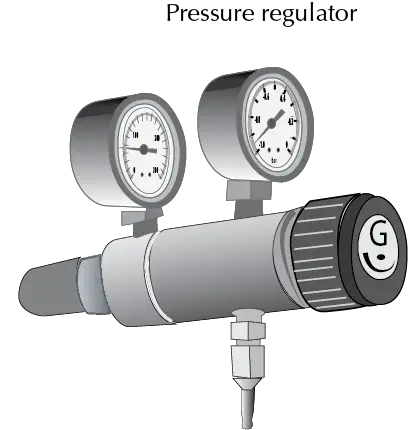
A manometer is an instrument for measuring absolute pressure, differential pressure between two zones or vacuum in gases or liquids. To measure vacuum, so-called vacuum gauges are used, which are a special type of pressure gauges that measure pressures lower than atmospheric pressure. There are mechanical or mercury gauges. Mechanical gauges are used in centralized vacuum systems or in certain vacuum pumps that incorporate them as part of their mechanism.
For centralized vacuum systems and gas bullets, in most cases, it is necessary to reduce the gas outlet pressure to a lower value. This operation is carried out with a valve called a pressure reducer, which has two pressure gauges that measure the gas pressure at the source and at the outlet.
McLeod gauge
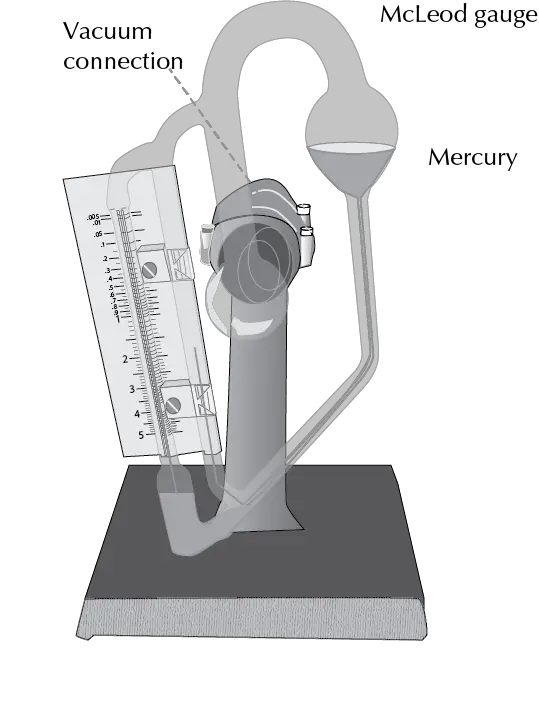
Within this section of vacuum and pressure equipment, we also find the so-called McLeod vacuum gauge. This is a vacuum gauge that measures pressures below atmospheric pressure accurately. This is done by means of a system of thin glass tubes (capillaries) with mercury inside, coupled to a movable panel. The mercury is compressed with a sample of the system gas to be measured.
The device is placed horizontally and then gently tilted so that the mercury contained in the main bulb enters the capillaries. When the mercury reaches the cut-off line (gauging), the gas contained in the capillary on the left is trapped and isolated from the rest of the system, which causes the pressure to increase as the mercury continues to be poured in, which can be measured by observing a scale.
Schlenk vacuum line
The last of the vacuum and pressure equipment we describe is a device consisting of a two parallel glass tube interconnected by a system of three-way keys, which has several outlets for various samples. It is called a Schlenk line. In this, one of the tubes is connected to an inert gas source (nitrogen or argon), while the other tube is connected to a high vacuum pump. The output pressure is approximately 100 torr (gauge pressure regulators are available on the market that can work between 0 and 1000 torr).
It is used to work with compounds sensitive to oxidation by oxygen in the air and to remove solvent residues from air-sensitive samples.

With a key system, vacuum or inert atmosphere can be selected, without the need to move the sample from one line to another. A nitrogen-cooled vacuum trap (in a Dewar) is inserted between the high-vacuum pump and the device to prevent volatile compounds from passing into the pump and deteriorating it. At the other end of the branch, a vacuum gauge can be connected to check the quality of the vacuum at any time.
The inert gas source is adjusted so that there is an overpressure of about 100 g cm-2. This can be obtained with a pressure reduction manometer or with an oil bubbler connected to the other end of the glass branch.
References
- Isac-García, J.; Dobado, J. A.; Calvo-Flores, F. G.; and Martínez-García, H. (2015). Experimental Organic Chemistry Laboratory Manual. Elsevier Science & Technology. ISBN: 978-0-12-803893-2